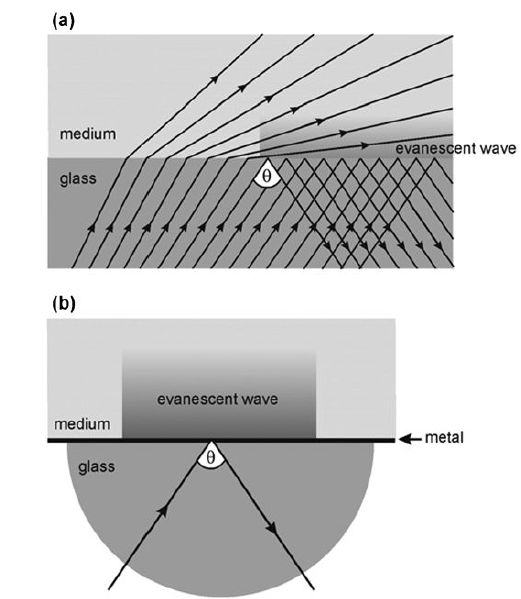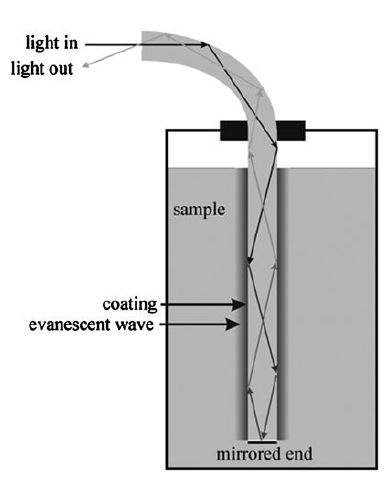


 النبات
النبات
 الحيوان
الحيوان
 الأحياء المجهرية
الأحياء المجهرية
 علم الأمراض
علم الأمراض
 التقانة الإحيائية
التقانة الإحيائية
 التقنية الحيوية المكروبية
التقنية الحيوية المكروبية
 التقنية الحياتية النانوية
التقنية الحياتية النانوية
 علم الأجنة
علم الأجنة
 الأحياء الجزيئي
الأحياء الجزيئي
 علم وظائف الأعضاء
علم وظائف الأعضاء
 الغدد
الغدد
 المضادات الحيوية
المضادات الحيوية|
Read More
Date: 23-1-2021
Date: 19-12-2020
Date: 18-1-2021
|
Evanescent Wave Biosensors
A light beam will be totally reflected when it strikes an interface between two transparent media, from the side with the higher refractive index, at angles of incidence (θ) greater than the critical angle (Figure 1.a).
This is the principle that allows transparent fibres to be used as optical waveguides. At the point of reflection an electromagnetic field is induced which penetrates into the medium with the lower refractive index, usually air or water. This field is called the evanescent wave and it rapidly decays exponentially with the penetration distance and generally has effectively disappeared within a few hundred nanometres. The exact depth of penetration depends on the refractive indices and the wavelength of the light and can be controlled by the angle of incidence. The evanescent wave may interact with the medium and the resultant electromagnetic field may be coupled back into the higher refractive index medium (usually glass) by essentially the reverse process. This gives rise to changes in the light emitted down the waveguide. Thus, it can be used to detect changes occurring in the liquid medium. The necessary surface interactions impose a limitation on the sensitivity of such devices at about 10 pgmm-2 and the requirement to limit non-specific absorption.

Figure . Production of (a) an evanescent wave and (b) surface plasmon resonance. At acute enough angles of incidence the light is totally internally reflected at the glass surface. In (a) an evanescent wave extends from this surface into the air or water medium. This process is amplified in (b) by the presence of the thin metal film.
Various effects, dependent on the biological sensing processes, can be determined, including changes in absorption, optical activity, fluorescence and luminescence. Because of the small degree of penetration, this system is particularly sensitive to biological processes in the immediate vicinity of the surface and independent of any bulk processes or changes.
Due to the small pathlength through the solution, it can even be used for the continuous monitoring of apparently opaque solutions. This biosensor configuration is particularly suitable for immunoassays as there is no need to separate bulk components since the wave only penetrates as far as the antibody–antigen complex. Surface-bound fluorophores may be excited by the evanescent wave and the excited light output detected after it is coupled back into the fibre (Figure 2.).

Figure 2. The principle behind evanescent wave immunosensor. The light output is reduced by absorption within the evanescent wave.
Sensors can be fabricated which measure oxidase substrates using the principle of quenching of fluorescence by molecular oxygen as described earlier. Another advantage of only sensing a surface reaction less than 1 mm thick is that the volume of analyte needed may be very small indeed, that is, less than 1 nl using suitable fluid transfer microfluidics.
Protein A, an important immunoglobulin-binding protein from Staphylococcus aureus, has been determined by this method using a plastic optical fibre coated with its antibody. Detection was by the fluorescence of a fluorescein-bound anti-protein A immunoglobulin which was subsequently bound, sandwiching the protein A.



|
|
|
|
طبيبة تبدد 5 خرافات رئيسية عن تغذية الأطفال
|
|
|
|
|
|
|
وفاة أول رجل خضع لزراعة كلية خنزير.. والمستشفى يوضح الأسباب
|
|
|
|
|
|
بالصور: ستفتتحه العتبة الحسينية الاسبوع المقبل.. شاهد ما يحتويه مستشفى الثقلين لعلاج الاورام في البصرة من اجهزة طبية
|
|
|
|
صممت على الطراز المعماري الإسلامي وتضم (16) قبة.. تعرف على نسب الإنجاز بقاعة علي الأكبر (ع) ضمن مشروع صحن عقيلة زينب (ع)
|
|
|
|
عبر جناحين.. العتبة الحسينية تشارك في معرض طهران الدولي للكتاب
|
|
|
|
بالفيديو: بحضور الامين العام للعتبة الحسينية وبالتعاون مع جامعتي واسط والقادسية.. قسم الشؤون الفكرية والثقافية يقيم المؤتمر العلمي الدولي الثالث تحت عنوان (القرآن الكريم والعربية آفاق و إعجاز)
|